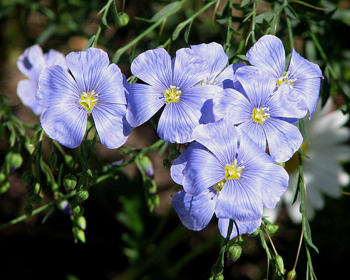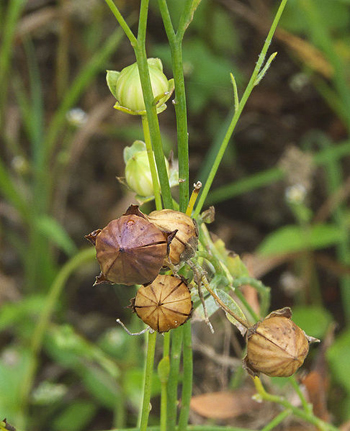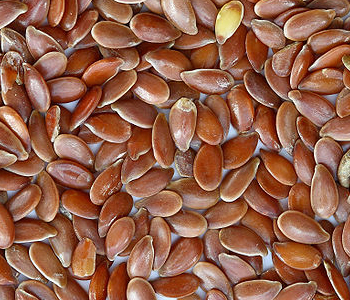Contents:
Common Names | Parts Usually Used | Plant(s) & Culture | Where Found | Medicinal Properties | Biochemical Information
Legends, Myths and Stories | Uses | Formulas or Dosages | Nutrient Content | How Sold | Warning | Resource Links | Bibliography
Scientific Names

- Linum usitatissimum L.
- Linaceae
- Flax family
Common Names
- Chih-ma (Chinese name)
- Common flax
- Flax seed
- Flax weed
- Linseed
- Lint bells
- Toad flax
- Uma (Sanskrit name)
- Winterlien
Parts Usually Used
Seeds
Back to Top

Description of Plant(s) and Culture
Flax is a delicate annual plant 8-22 inches high; the slender, wiry, glabrous, single, leafy, stem has few branches and bears alternate, sessile, simple, entire, lanceolate to oblong, linear, leaves. The numerous leaves are stalkless, alternate, linear with three parallel nerves. Each branch has one or two, delicate, blue or violet-blue, five-petaled, funnel-shaped, slightly overlapping petals (1/2-3/4 inches across), flowers from June to August. The fruit is an 8- to 10-seeded capsule; the seeds are smooth, flattened, shiny, oval beaked, and light brown. Zones 5-10. Not heat-tolerant. This is the common flaxseed.
Another flax plant, purging flax or fairy flax (Linum catharticum), is common in European meadows and pastures. It has opposite leaves and white flowers. In small quantities the plant has purgative properties; in large quantities it is emetic. An infusion of the dried herb is used.
Caution: large quantities of purging flax can cause fatal poisoning.
Another variety: Blue flax (Linum Lewisii) is known to the Shoshone Indians as “Poohi natesua.” This plant’s root was steeped for eye medicine. The Paiute Indians called it “Alai natesua” and the whole stem was steeped and used for disorders of the stomach and gas.
Back to Top
Where Found
Widely cultivated in the United States (mostly the northwestern states), Canada, and Europe but also found wild along roadsides, railroad lines, old fields, and in waste places. Native to Europe.
Back to Top
Medicinal Properties
Antiseptic, anti-inflammatory, anti-tussive, demulcent, emollient, laxative, mucilaginous, pectoral, purgative, tonic
Back to Top
Biochemical Information
Glycosides, gum, linamarin, linoleic acid, linolenic acids, mucilage, oleic acid, protein, saturated acids, tannins, and wax, vitamins A, B, D, E, minerals and amino acids
Back to Top

Legends, Myths and Stories
Only mankind eats the starch from the seed and throws away the materials necessary for the metabolism of that starch.
The mucilage of the flaxseed, obtained by boiling in water or wine was once used to give body to red wines.
Cotton and flax were among the earliest substances used for cloth fabric, having been found throughout remains from ancient Egypt and in both the old and new worlds. (linen and linsey-woolsey) Cultivated since at least 5,000 BC. Egyptian mummies were wrapped in linen cloth woven from the stalks of the flax plant.
As early as the Mesolithic period, it was known to man for its usefulness. In that era, flax provided both oil and fiber for garments, as the remains of prehistoric lake dwellers in Switzerland indicate.
In 8th century France, Charlemagne passed laws requiring his subjects to consume the seeds to keep the people healthy.
The cultivation of flax in Egypt can be traced back to the 14th century BC; flaxseed intended as provisions for the last journey was found in Egyptian burial chambers. Hippocrates (around 500 BC) and Paracelsus (Theophrastus von Hohenheim 1493-1541) refer to flaxseed mucilage as a soothing cough remedy.
The flax herb is cultivated in China for its seeds and oil.
Back to Top
Uses
Source of linseed oil and linen. Said to be soothing and softening to irritated membranes.
The ground seed mixed with boiling water to make a thick mush is used for poultices. Any herb, such as smartweed, elm bark, hops, mullein, or any other herbs recommended, can be added. Use as a poultice on old sores, boils, inflammations, skin ulcers, wounds, and tumors. Poultices should be changed at least every 2 hours; have a new, hot poultice ready to apply before the old one is removed.
Used for female disorders, colon problems. Promotes strong nails, bones, and teeth and healthy skin. A decoction of the seeds can be used for coughs, catarrh, chronic bronchitis, asthma, pleurisy, fever, dropsy, leprosy, pimples, age spots, burns, scalds, gout, inflammation, cystitis, lung and chest problems, and digestive, gastritis, dyspepsia, diarrhea, and urinary disorders. To eliminate gallstones, take 1 1/2 to 2 tbsp. linseed oil and lie down on your left side for a half hour. The gallstones will pass into the intestines and be eliminated from there. Eating the seeds intact is useful for chronic constipation. The seeds swell up in the intestines, encouraging elimination by increasing the volume of fecal matter. For emollient uses and for rheumatic complaints, apply a linseed poultice. The oil was a folk remedy used for pleurisy and pneumonia.
The seed has been used for ages as a medicine. Take 1 tsp. of the whole seed mixed with water, orange juice, vegetable juice, etc., to provide a gentle lubricant laxative. Or use this mixture as an enema.
To remove foreign bodies from the eye: place a grain of whole flaxseed under the lower lid, close the lids. The seed becomes surrounded by a thick, adherent mucilage, which entraps the foreign body, and soon carries it out from the angle of the eye. If the particle is not removed easily, consult a doctor.
Linseed oil is obtained from the crushed seeds. Flax is also grown for the linen fibers which are obtained from the stems.
Oils from the seeds used in many medications, paints and linoleum.
A flaxseed placed in the eye will remove any foreign matter in the eye.
Back to Top
Formulas or Dosages
Use only ripe seeds. Immature seed pods can cause poisoning.
Infusion: use 1 tsp. seed in 1 cup boiling water, let cool and take 1 or 2 mouthfuls 3 times a day.
Decoction: use 1 tbsp. seed with 1 qt. water. Boil until 1/2 qt. liquid remains. Take in the course of a day.
Poultice: Cook seeds until they are soft (or use pulverized seed). Put them immediately into a linen bag and apply as hot as can be tolerated.
Seeds: For constipation, take 1-2 tbsp. whole seeds, washing them down with lots of water. If necessary, follow with stewed prunes.
Back to Top
Nutrient Content
Vitamins A, B, D, E, minerals and amino acids, Omega-3 fatty acid
Back to Top
How Sold
Linseed oil
Flax seeds
Back to Top
Warning
Flaxseeds may not be strong enough for severe constipation and may feed congestion in the colon. Seek professional medical advise if severely constipated or blood in the stool.
Linseed oil deteriorates rapidly, prepare fresh often. DO NOT take artist’s linseed oil internally.
Immature seed pods can cause poisoning.
Caution: large quantities of purging flax can cause fatal poisoning.
Contains a cyanide-like compound. Oil may be emetic and purgative.
Overdoses cause respiratory distress and paralysis.
Back to Top
Resource Links
LiveStrong.com: Is Flaxseed Good for Hormones? ‘
LiveStrong.com: What Does Flax Oil Do for a Diet?
LiveStrong.com: Does Flaxseed Oil Reduce Cholesterol?
LiveStrong.com: Natural Methods for Lowering Triglycerides & Cholesterol
MayoClinic.com: Cholesterol-lowering supplements
University of Maryland Medical Center: Flaxseed
Memorial Sloan-Kettering Cancer Center: Flaxseed
U.S. National Library of Medicine: Flaxseed & Flaxseed Oil
National Center for Complementary & Alternative Medicine: Flaxseed & Flaxseed Oil
Mayo Clinic: Flaxseed & Flaxseed Oil
PubMed.gov: Flaxseed reduces total and LDL cholesterol in Native American postmenopausal women.
PubMed.gov: Experimental and clinical research findings on the cardiovascular benefits of flaxseed.
PubMed.gov: Flaxseed extract lowers cholesterol and glucose in hypercholesterolaemic subjects.
Bibliography
![]() The Herb Book
The Herb Book, by John Lust, Bantam Books, 666 Fifth Avenue, New York, NY. copyright 1974.
![]() Back to Eden
Back to Eden, by Jethro Kloss; Back to Eden Publishing Co., Loma Linda, CA 92354, Original copyright 1939, revised edition 1994
 Secrets of the Chinese Herbalists
Secrets of the Chinese Herbalists, by Richard Lucas, Parker Publishing Company, Inc., West Nyack, NY, 1987.
![]() The Complete Medicinal Herbal
The Complete Medicinal Herbal, by Penelope Ody, Dorling Kindersley, Inc, 232 Madison Avenue, New York, NY 10016, First American Edition, copyright 1993
![]() Indian Herbalogy of North America
Indian Herbalogy of North America, by Alma R. Hutchens, Shambala Publications, Inc., Horticultural Hall, 300 Massachusetts Avenue, Boston, Massachusetts 02115, 1973
![]() The Herbalist Almanac
The Herbalist Almanac, by Clarence Meyer, Meyerbooks, publisher, PO Box 427, Glenwood, Illinois 60425, copyright 1988, fifth printing, 1994
![]() Culpeper’s Complete Herbal & English Physician
Culpeper’s Complete Herbal & English Physician, by Nicholas Culpeper, Meyerbooks, publisher, PO Box 427, Glenwood, Illinois 60425, 1990, (reprint of 1814)
![]() Indian Uses of Native Plants
Indian Uses of Native Plants, by Edith Van Allen Murphey, Meyerbooks, publisher, PO Box 427, Glenwood, Illinois 60425, copyright 1958, print 1990
![]() Chinese Medicinal Herbs
Chinese Medicinal Herbs, compiled by Shih-Chen Li, Georgetown Press, San Francisco, California, 1973.
 Old Ways Rediscovered
Old Ways Rediscovered, by Clarence Meyer, Meyerbooks, publisher, PO Box 427, Glenwood, Illinois 60425, published from 1954, print 1988
![]() Eastern/Central Medicinal Plants
Eastern/Central Medicinal Plants, by Steven Foster and James A. Duke., Houghton Mifflin Company, 215 Park Avenue South, New York, NY 10000
Herbal Gardening, compiled by The Robison York State Herb Garden, Cornell Plantations, Matthaei Botanical Gardens of the University of Michigan, University of California Botanical Garden, Berkeley., Pantheon Books, Knopf Publishing Group, New York, 1994, first edition
![]() Planetary Herbology
Planetary Herbology, by Michael Tierra, C.A., N.D., O.M.D., Lotus Press, PO Box 325, Twin Lakes. WI 53181., Copyright 1988, published 1992
![]() American Folk Medicine
American Folk Medicine, by Clarence Meyer, Meyerbooks, publisher, PO Box 427, Glenwood, Illinois 60425, 1973
![]() Prescription for Nutritional Healing
Prescription for Nutritional Healing, by James F. Balch, M.D. and Phyllis A. Balch, C.N.C., Avery Publishing Group, Inc., Garden City Park, NY
![]() Webster’s New World Dictionary
Webster’s New World Dictionary, Third College Edition, Victoria Neufeldt, Editor in Chief, New World Dictionaries: A Division of Simon & Schuster, Inc., 15 Columbus Circle, New York, NY 10023, 1984
 An Instant Guide to Medicinal Plants
An Instant Guide to Medicinal Plants, by Pamela Forey and Ruth Lindsay, Crescent Books (January 27, 1992).
![]() The Yoga of Herbs
The Yoga of Herbs, by Dr. David Frawley & Dr. Vasant Lad, Lotus Press, Twin Lakes, Wisconsin, Second edition, 1988.
 The Rodale Herb Book
The Rodale Herb Book, edited by William H. Hylton, Rodale Press, Inc. Emmaus, PA, 18049., 1974
 The Healing Plants
The Healing Plants, by Mannfried Pahlow, Barron’s Educational Series, Inc. 250 Wireless Blvd., Hauppauge, NY 11788, 1992
